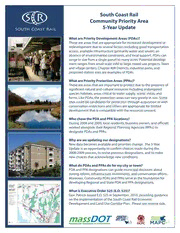
South Coast Rail Community Priority Area 5-Year Update Brochure PDF
Preview South Coast Rail Community Priority Area 5-Year Update Brochure
South Coast Rail Community Priority Area 5-Year Update What are Priority Development Areas (PDAs)? These are areas that are appropriate for increased development or redevelopment due to several factors including good transportation access, available infrastructure (primarily water and sewer), an absence of environmental constraints, and local support. PDAs can range in size from a single parcel to many acres. Potential develop- ment ranges from small-scale infill to large mixed-use projects. Town and village centers, Chapter 40R Districts, industrial parks, and proposed station sites are examples of PDAs. What are Priority Protection Areas (PPAs)? These are areas that are important to protect due to the presence of significant natural and cultural resources including endangered species habitats, areas critical to water supply, scenic vistas, and farms. Like PDAs, the protection areas can vary greatly in size. Some sites could be candidates for protection through acquisition or with conservation restrictions and others are appropriate for limited development that is compatible with the resources present. Who chose the PDA and PPA locations? During 2008 and 2009, local residents, business owners, and officials worked alongside their Regional Planning Agencies (RPAs) to designate PDAs and PPAs. Why are we updating our designations? New data becomes available and priorities change. The 5-Year Update is an opportunity to confirm choices made during the 2008-2009 process, to revise previous designations, and to make new choices that acknowledge new conditions. What do PDAs and PPAs do for my city or town? PDA and PPA designations can guide municipal decisions about zoning reform, infrastructure investments, and conservation efforts. Moreover, Community PDAs and PPAs serve as the foundation for developing Regional and State PDA and PPA designations. What is Executive Order 525 (E.O. 525)? Gov. Patrick issued E.O. 525 in September, 2010, providing guidance on the implementation of the South Coast Rail Economic Development and Land Use Corridor Plan. Please see reverse side. OCPC South Coast Rail Community Priority Area 5-Year Update Executive Order 525 (E.O. 525) In fall 2010, Gov. Patrick issued Executive Order 525 (E.O. 525) providing for the implementation of the Corridor Plan and Corridor Map through state agency actions and investments. The Executive Order calls for state investments to be consistent with the Corridor Plan’s recommendations to the maximum extent feasible. These state actions have the potential to leverage local and private investments in the priority areas. The Executive Order also directs state agencies to conduct a retrospective analysis to determine how consistent their actions and investments in the region have been with the Corridor Plan goals. Based upon the issuance of E.O. 525 in fall 2010, state agencies must now consider plan consistency when making funding decisions. In order to facilitate the consideration of E.O. 525 in the decision making process, all state agencies have outlined the steps they will take to maximize compliance with the Corridor Plan into their investment decision making process. As an example of the type of actions that have been taken, many state program applications now require that applicants from the 31 cities and towns in the South Coast Corridor outline how their project is consistent with the Corridor Plan. For more information go to: http://www.mass.gov/hed/economic/eohed/pro/planning/south coast/executive-order-525/ Jean Fox, South Coast Rail Project Manager MassDOT 10 Park Plaza, Suite 4150 Boston, MA 02116 [email protected] 617‐973‐7314 http://www.southcoastrail.com/ OCPC
